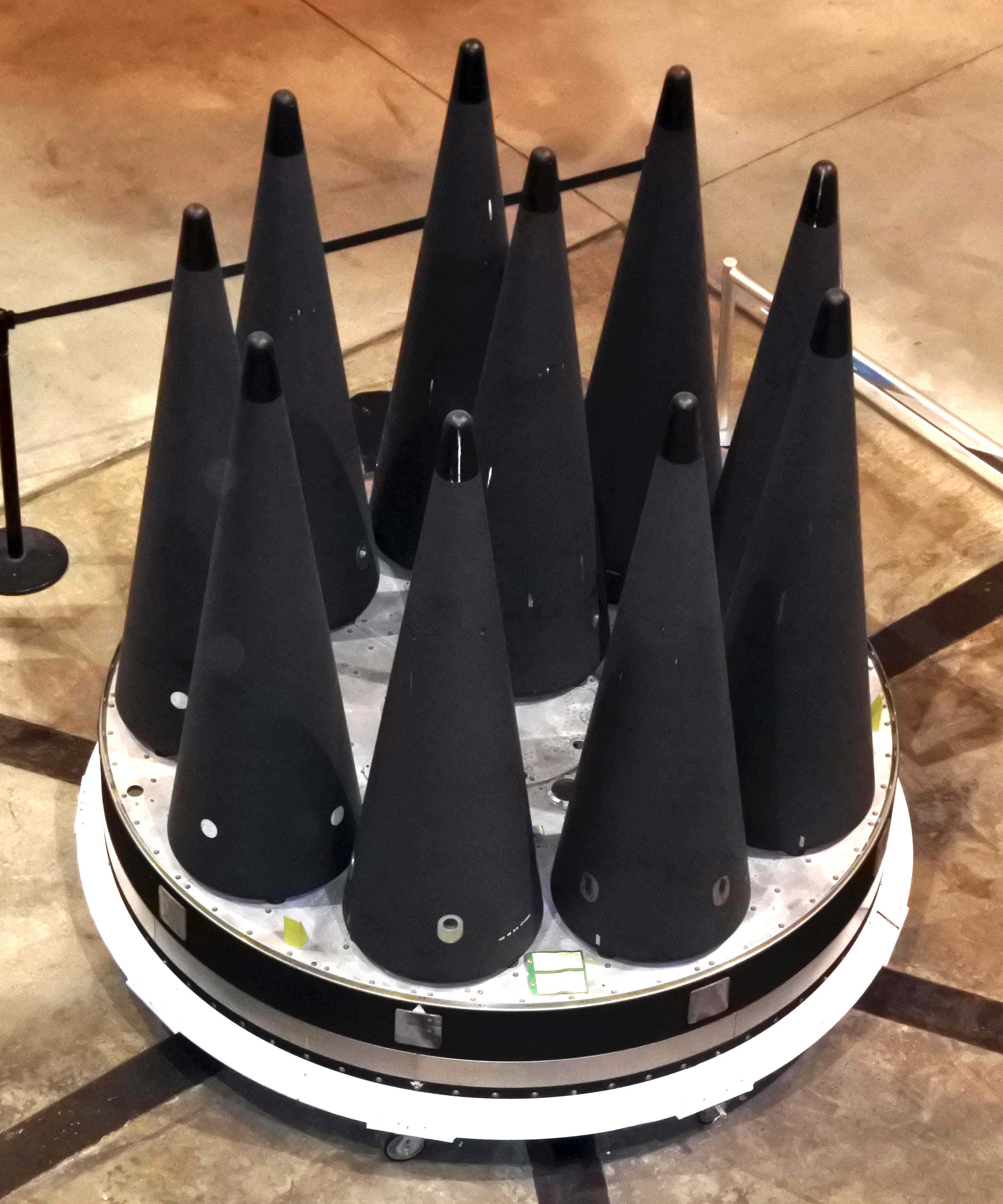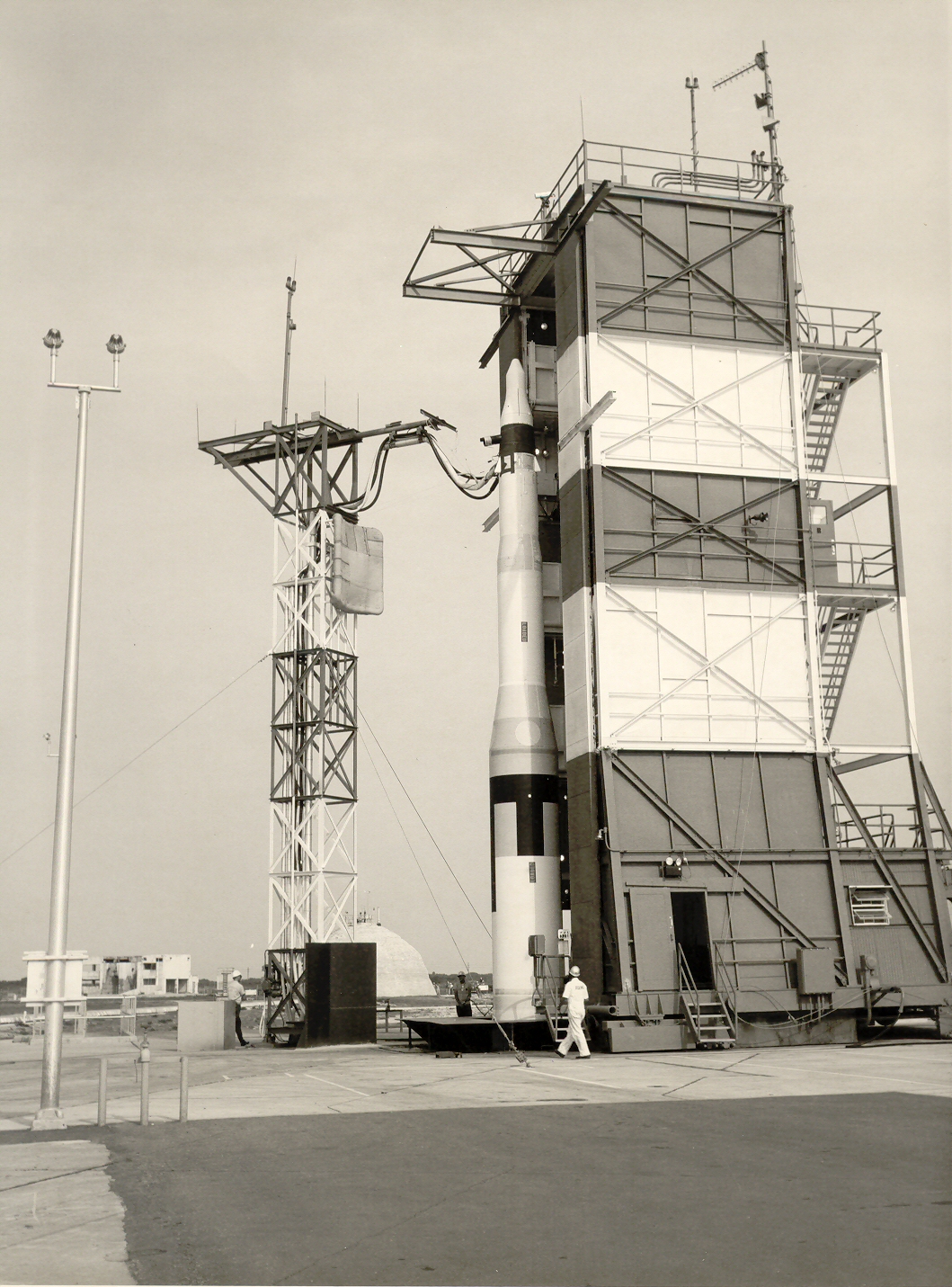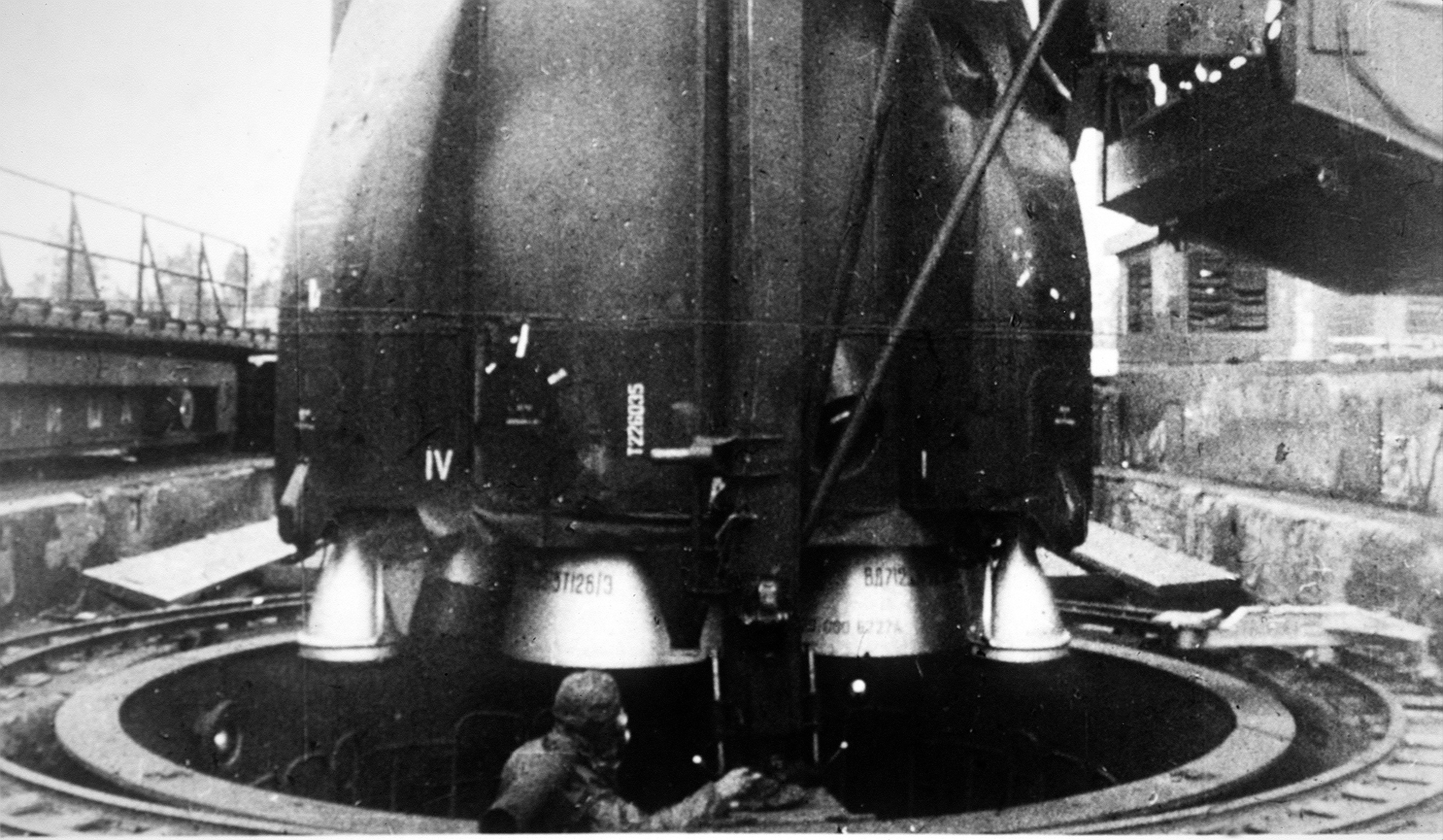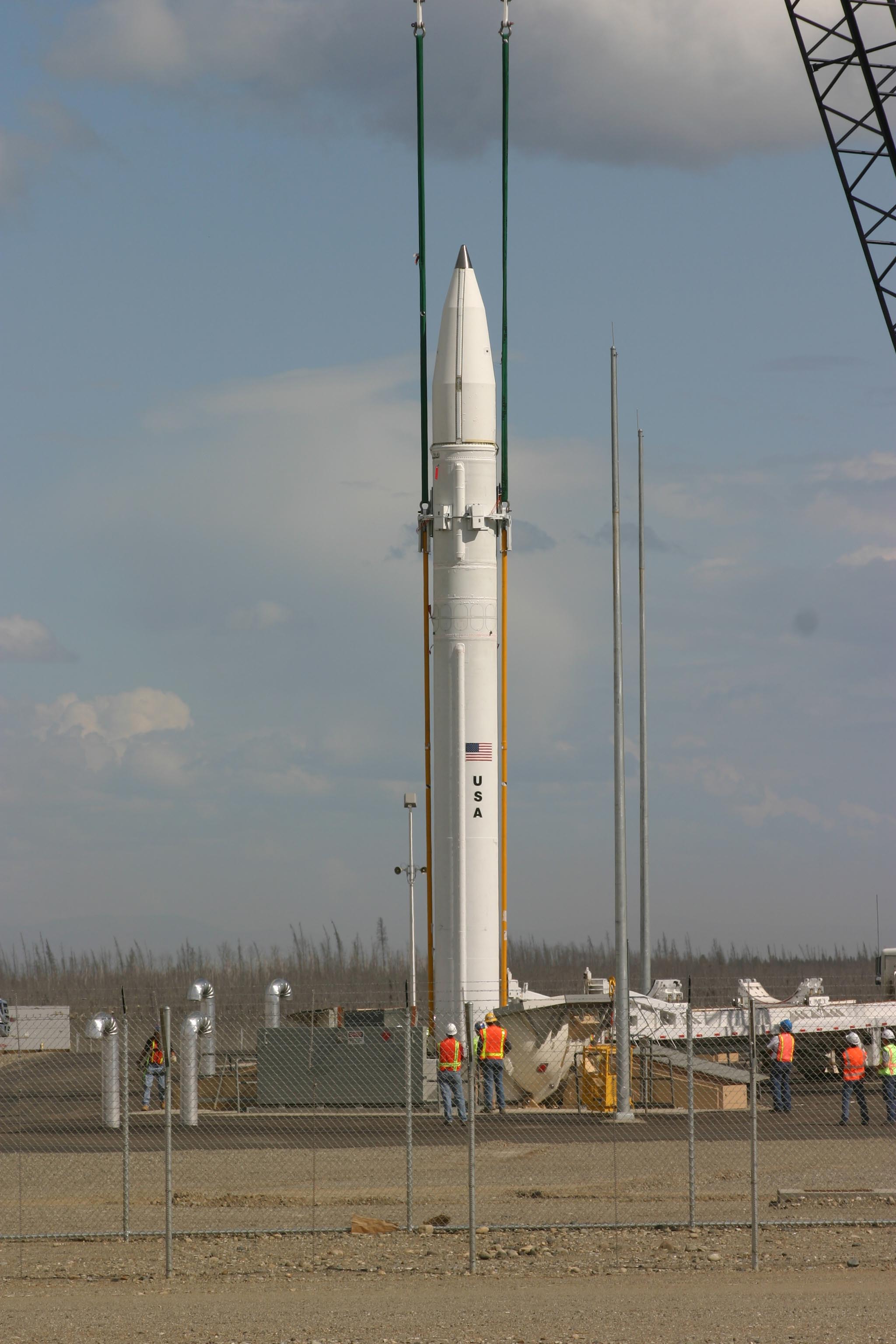|
MIRV
A multiple independently targetable reentry vehicle (MIRV) is an exoatmospheric ballistic missile payload containing several warheads, each capable of being aimed to hit a different target. The concept is almost invariably associated with intercontinental ballistic missiles carrying thermonuclear warheads, even if not strictly being limited to them. An intermediate case is the multiple reentry vehicle (MRV) missile which carries several warheads which are dispersed but not individually aimed. All nuclear-weapon states except Pakistan and North Korea are currently confirmed to have deployed MIRV missile systems. The first true MIRV design was the Minuteman III, first successfully tested in 1968 and introduced into actual use in 1970. The Minuteman III held three smaller W62 warheads, with yields of about each in place of the single W56 used on the Minuteman II. From 1970 to 1975, the United States would remove approximately 550 earlier versions of the Minuteman ... [...More Info...] [...Related Items...] OR: [Wikipedia] [Google] [Baidu] |
Mutual Assured Destruction
Mutual assured destruction (MAD) is a doctrine of military strategy and national security policy which posits that a full-scale use of nuclear weapons by an attacker on a nuclear-armed defender with second-strike capabilities would result in the complete annihilation of both the attacker and the defender. It is based on the theory of rational deterrence, which holds that the threat of using strong weapons against the enemy prevents the enemy's use of those same weapons. The strategy is a form of Nash equilibrium in which, once armed, neither side has any incentive to initiate a conflict or to disarm. The result may be a nuclear peace, in which the presence of nuclear weapons decreases the risk of crisis escalation, since parties will seek to avoid situations that could lead to the use of nuclear weapons. Proponents of nuclear peace theory therefore believe that controlled nuclear proliferation may be beneficial for global stability. Critics argue that nuclear proliferation i ... [...More Info...] [...Related Items...] OR: [Wikipedia] [Google] [Baidu] |
Minuteman III
The LGM-30 Minuteman is an American land-based intercontinental ballistic missile (ICBM) in service with the Air Force Global Strike Command. , the LGM-30G (Version 3) is the only land-based ICBM in service in the United States and represents the land leg of the U.S. nuclear triad, along with the Trident II submarine-launched ballistic missile (SLBM) and nuclear weapons carried by long-range strategic bombers. Development of the Minuteman began in the mid-1950s when basic research indicated that a solid-fuel rocket motor could stand ready to launch for long periods of time, in contrast to liquid-fueled rockets that required fueling before launch and so might be destroyed in a surprise attack. The missile was named for the colonial minutemen of the American Revolutionary War, who could be ready to fight on short notice. The Minuteman entered service in 1962 as a deterrence weapon that could hit Soviet cities with a second strike and countervalue counterattack if the U.S. was att ... [...More Info...] [...Related Items...] OR: [Wikipedia] [Google] [Baidu] |
First-strike
In nuclear strategy, a first strike or preemptive strike is a preemptive surprise attack employing overwhelming force. First strike capability is a country's ability to defeat another nuclear power by destroying its arsenal to the point where the attacking country can survive the weakened retaliation while the opposing side is left unable to continue war. The preferred methodology is to attack the opponent's strategic nuclear weapon facilities (missile silos, submarine bases, bomber airfields), command and control sites, and storage depots first. The strategy is called counterforce. Historical background ''First-strike attack'', the use of a nuclear first strike capability, was greatly feared during the Cold War between NATO and the Soviet Bloc. At various points, fear of a first strike attack existed on both sides. Misunderstood changes in posture and well understood changes in technology used by either side often led to speculation regarding the enemy's intentions. 1948 ... [...More Info...] [...Related Items...] OR: [Wikipedia] [Google] [Baidu] |
Intercontinental Ballistic Missile
An intercontinental ballistic missile (ICBM) is a ballistic missile with a range (aeronautics), range greater than , primarily designed for nuclear weapons delivery (delivering one or more Thermonuclear weapon, thermonuclear warheads). Conventional weapon, Conventional, Chemical weapon, chemical, and Biological agent, biological weapons can also be delivered with varying effectiveness, but have never been deployed on ICBMs. Most modern designs support multiple independently targetable reentry vehicle (MIRVs), allowing a single missile to carry several warheads, each of which can strike a different target. The Nuclear weapons of the United States, United States, Russia and weapons of mass destruction, Russia, China and weapons of mass destruction, China, France and weapons of mass destruction, France, India and weapons of mass destruction, India, the United Kingdom and weapons of mass destruction, United Kingdom, Nuclear weapons and Israel, Israel, and North Korea and weapons of ... [...More Info...] [...Related Items...] OR: [Wikipedia] [Google] [Baidu] |
R-36 (missile)
The R-36 () is a family of intercontinental ballistic missiles (ICBMs) and space launch vehicles (Tsyklon) designed by the Soviet Union during the Cold War. The original R-36 was deployed under the GRAU index 8K67 and was given the NATO reporting name SS-9 Scarp. It was able to carry three warheads and was the first Soviet MIRV (multiple re-entry vehicle, multiple independently targetable re-entry vehicle) missile. The later version, the R-36M, also known as RS20, was produced under the GRAU designations 15A14 and 15A18 and was given the NATO reporting name SS-18 Satan. This missile was viewed by certain United States analysts as giving the Soviet Union Pre-emptive nuclear strike, first strike advantage over the U.S., particularly because of its rapid silo-reload ability, very heavy throw weight and extremely large number of atmospheric re-entry, re-entry vehicles. Some versions of the R-36M were deployed with 10 warheads and up to 40 penetration aids and the missile's high thro ... [...More Info...] [...Related Items...] OR: [Wikipedia] [Google] [Baidu] |
Thermonuclear Weapon
A thermonuclear weapon, fusion weapon or hydrogen bomb (H-bomb) is a second-generation nuclear weapon design. Its greater sophistication affords it vastly greater destructive power than first-generation nuclear bombs, a more compact size, a lower mass, or a combination of these benefits. Characteristics of nuclear fusion reactions make possible the use of non-fissile depleted uranium as the weapon's main fuel, thus allowing more efficient use of scarce fissile material. Its multi-stage design is distinct from the usage of fusion in simpler Boosted fission weapon, boosted fission weapons. The first full-scale thermonuclear test (Ivy Mike) was carried out by the United States in 1952, and the concept has since been employed by at least the five recognized List of states with nuclear weapons#Recognized nuclear-weapon states, nuclear-weapon states and United Nations Security Council, UNSC Permanent members of the United Nations Security Council, permanent members: the Nuclear weapons ... [...More Info...] [...Related Items...] OR: [Wikipedia] [Google] [Baidu] |
LGM-118A Peacekeeper MIRV
The LGM-118 Peacekeeper, originally known as the MX for "Missile, Experimental", was a MIRV-capable intercontinental ballistic missile (ICBM) produced and deployed by the United States from 1986 to 2005. The missile could carry up to eleven Mark 21 reentry vehicles (although treaties limited its actual payload to ten), each armed with a 300-kiloton W87 warhead. Initial plans called for building and deploying 100 MX ICBMs, but budgetary concerns limited the final procurement; only 50 entered service. Disarmament treaties signed after the Peacekeeper's development led to its withdrawal from service in 2005. Studies on the underlying concept started in the 1960s. The idea was to allow the US to absorb a sneak attack by the USSR with enough warheads surviving to attack the remaining Soviet missile silos. To do so, the missiles had to be highly accurate, be based in such a way that enough would survive a nuclear attack, carry a large number of warheads so the survivors would still in ... [...More Info...] [...Related Items...] OR: [Wikipedia] [Google] [Baidu] |
Ballistic Missile
A ballistic missile is a type of missile that uses projectile motion to deliver warheads on a target. These weapons are powered only during relatively brief periods—most of the flight is unpowered. Short-range ballistic missiles (SRBM) typically stay within the Earth's atmosphere, while most larger missiles travel outside the atmosphere. The type of ballistic missile with the greatest range is an intercontinental ballistic missile (ICBM). The largest ICBMs are capable of full orbital flight. These missiles are in a distinct category from cruise missiles, which are aerodynamically guided in powered flight and thus restricted to the atmosphere. History One modern pioneer ballistic missile was the A-4, commonly known as the V-2, developed by Nazi Germany in the 1930s and 1940s under the direction of Wernher von Braun. The first successful launch of a V-2 was on October 3, 1942, and it began operation on September 6, 1944, against Paris, followed by an attack on London two ... [...More Info...] [...Related Items...] OR: [Wikipedia] [Google] [Baidu] |
Oreshnik (missile)
Oreshnik (), is a Russian intermediate-range ballistic missile (IRBM) characterized by its reported speed exceeding , according to the Ukrainian military. The missile is equipped with six warheads, each reportedly containing submunitions, and has been described as highly difficult to intercept, though modern ballistic missile interceptors are designed to counter this type of system. Deputy Pentagon Press Secretary Sabrina Singh has identified the Oreshnik as a variant of the RS-26 Rubezh IRBM. History Development Oreshnik is believed to be derived from the RS-26 Rubezh IRBM, which has been test-fired five times but never entered service. According to experts, the Oreshnik likely removed a booster stage from the RS-26, reducing its range. First operational use The Oreshnik saw its first confirmed operational use on 21 November 2024, during the Russo-Ukrainian War. The missile was employed in an attack on Ukraine's PA Pivdenmash facility in Dnipro. Initially, Ukrainia ... [...More Info...] [...Related Items...] OR: [Wikipedia] [Google] [Baidu] |
Anti-ballistic Missile
An anti-ballistic missile (ABM) is a surface-to-air missile designed to Missile defense, destroy in-flight ballistic missiles. They achieve this explosively (chemical or nuclear), or via hit-to-kill Kinetic projectile, kinetic vehicles, which may also have self-maneuvering. Tactical systems are widely deployed to counter Short-range ballistic missile, short and Intermediate-range ballistic missile, intermediate-range ballistic missiles that carry conventional weapon, conventional warheads. Strategic systems, deployed by the United States, Russia, and Israel, are capable of intercepting intercontinental ballistic missiles, typically used to carry Strategic nuclear weapon, strategic nuclear warheads. During the Cold War, the 1972 ABM Treaty limited the nuclear arms race; excessive ICBM production would have been favoured to overwhelm ABM systems. Of the modern strategic ABM systems, only Russia's are themselves armed with nuclear warheads. Current counter-ICBM systems There are ... [...More Info...] [...Related Items...] OR: [Wikipedia] [Google] [Baidu] |
Anti-Ballistic Missile Treaty
The Anti-Ballistic Missile Treaty, also known as the ABM Treaty or ABMT, was an arms control treaty between the United States and the Soviet Union on the limitation of the anti-ballistic missile (ABM) systems used in defending areas against ballistic missile-delivered nuclear weapons. It was intended to reduce pressures to build more nuclear weapons to maintain Deterrence theory, deterrence. Under the terms of the treaty, each party was limited to two ABM complexes, each of which was to be limited to 100 anti-ballistic missiles. Signed in 1972, it was in force for the next 30 years. In 1997, five years after the Dissolution of the Soviet Union, dissolution of the Soviet Union, four Post-Soviet states, former Soviet republics agreed with the United States to succeed the USSR's role in the treaty, with Russia assuming all rights and obligations as the Succession of states#Russia and the Soviet Union, successor state of the Soviet Union. Citing purported risks of nuclear blackmail, ... [...More Info...] [...Related Items...] OR: [Wikipedia] [Google] [Baidu] |







